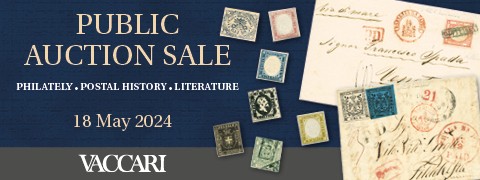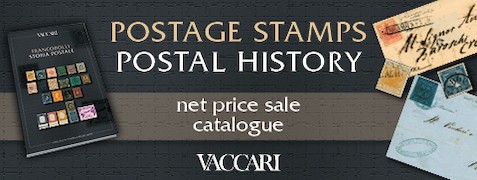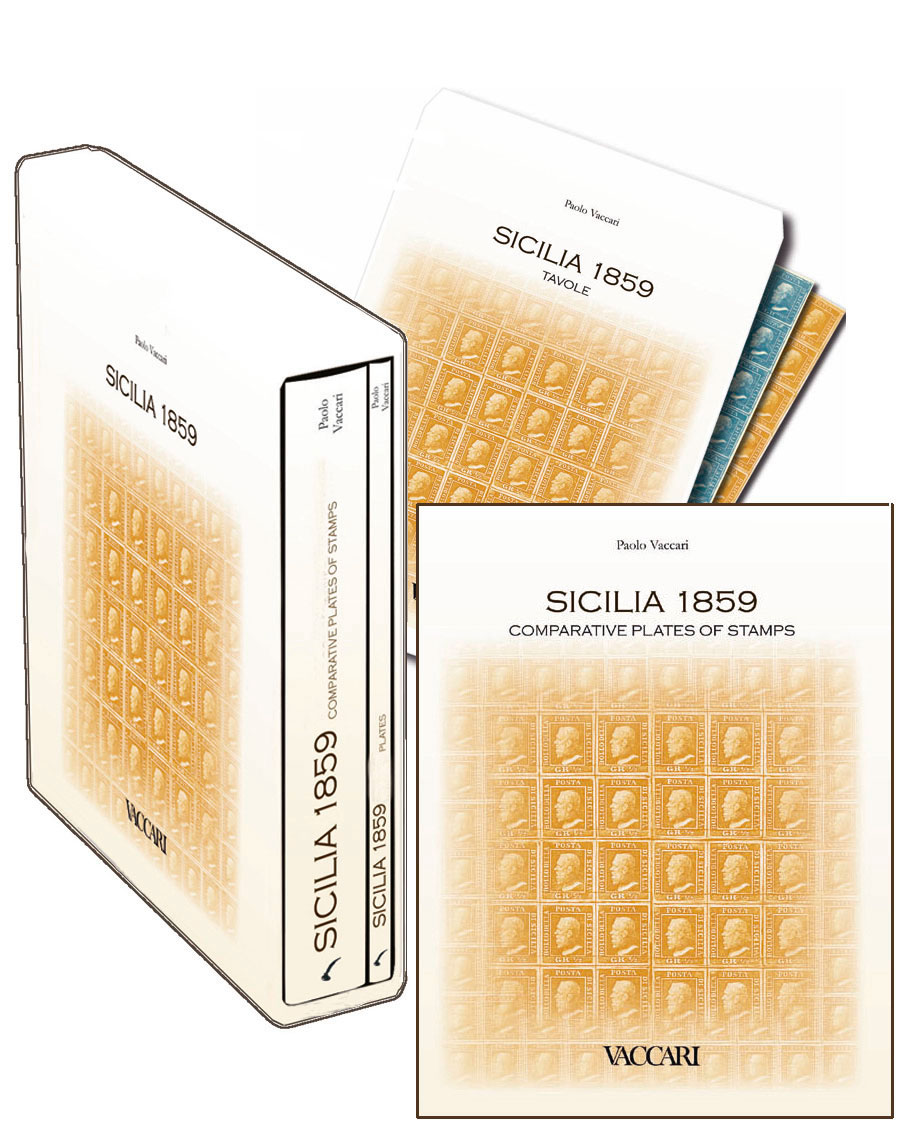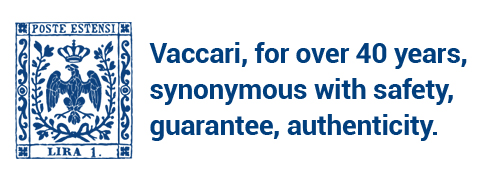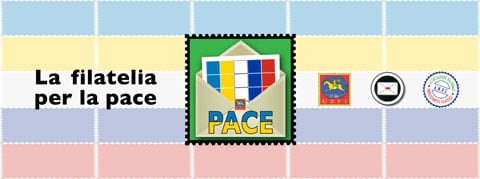Philatelic Bookshop
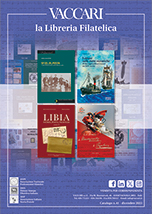
General catalogue
with recent updates
Philately and postal history, postcards, catalogues, colonies, forgeries, fiscals, handbooks, air mail, maritime and military, preadhesive, postal rates, thematics, numismatics and general collecting.
- active selection: PHILATELY AND POSTAL HISTORY delete selection
- ITALIAN STATES delete selection
- KINGDOM OF SICILY delete selection
Cod. 2201EN
EUR 140,00
Special Price
EUR 98,00
Paolo Vaccari
SICILIA 1859
COMPARATIVE PLATES OF STAMPS
COMPARATIVE PLATES OF STAMPS
in an elegant slip-case the comparative study and the 15 plates
128 pp. - fine art quality paper - format cm 24x31 - hardbound - printed 2009
series "Philatelic studies"
English text
2 edizioni - 2 editions
ITALIANO - ENGLISH
ISBN: 978-88-96381-03-8
FOR THE FIRST TIME IN COLOURSPreface by Nino Aquila and Francesco Lombardo.
Included in a slip-case, the present work stands out with respect to previous studies thanks to the detailed study, the updates, and the reproductions in colours.
The volume presents the plates life size and divided into four parts with the indication of the main characteristics for each stamp and the distinctive elements for each position in the sheet.
Collectors can compare the original copies checking position and variations.
Described in details even the retouches, reproduced enlarged.
Separately, gathered in a specific sleeve inside the slip-case, the 15 plates reproduced life size and in colours through the stochastic printing system to obtain better image definition and detail preciseness.
On the back of each plate, "fac-simile" has been printed to avoid any frauds.
CONTENTS
Preface by Nino Aquila
Presentation by Francesco Lombardo
Why the Comparative Plates of Sicilian Postage Stamps
The Kingdom of the Two Sicilies
The Postage Stamps of Sicily - Types
1/2 grano - plate 1
1/2 grano - plate 2
1 grano - plate 1 - I state
1 grano - plate 1 - II state
1 grano - plate 2
1 grano - plate 3
2 grana - plate 1
2 grana - plate 2
2 grana - plate 3
5 grana - plate 1 - Naples
5 grana - plate 1 - Palermo
5 grana - plate 2
10 grana - single plate
20 grana - single plate
50 grana - single plate
Bibliography
The author
Why the Comparative Plates of Sicilian Postage Stamps
Shortly after the General Direction of the Post of the Kingdom of Sardinia started selling, as collectibles, the remaining Bourbon stamps seized in the offices of the Island, the study of these magnificent rectangles of coloured paper began. Since then, they have been considered among the best made in the world.
As a matter of fact, a brief comparison with the other stamps available on the philatelic market at the beginning of the 1860's makes the artistic mastery of these Sicilian stamps immediately evident.
In 1863 the first studies of these stamps were published, and they were more and more specialized until Emilio Diena, the Great Master of the Italian philately, marked a milestone when he gave the fruit of his studies to the press in London in 1904. Since then, very little or almost nothing very innovative has been written about postage stamps. Some works, even recent ones, have only slightly dealt with the study of them, but they have brought to light some interesting findings on postal history and postmarks. Emilio Diena dedicated little time to these latter issues, not because he lacked knowledge, but rather because his research was only dedicated to "The History of Sicilian Postage Stamps".
The original edition, published in English in 1904, is practically untraceable. Both the later versions of the book are also difficult to find, the re-print in English, printed in 1969 by Giulio Bolaffi Editore and the Italian translated edition with notes added by Enzo Diena "Emilio Diena - Una vita per la Filatelia" (A Life Dedicated to Philately). The latter was published by the Post and Telecommunications Administration in 1989 on the occasion of the issuing of a stamp dedicated to the Great Master.
Now, in 2009, on the occasion of the 150th anniversary of Sicilian stamps, a new work, however following in the footsteps of Emilio Diena. Included in a slip-case are the work in colour with the comparative plates which are in all colour and have been analysed in detail in order to present their distinctive elements, and the complete and full size plates.
As one may notice this work is completely new in the layout and printing method implemented as we have not used the traditional four-colour screen or digital printing. This as a consequence of our belief that these two "archaic systems" would damage the fine detailed print of the plates and their portions, which are necessary to better compare them with the originals. We have chosen to use the stochastic printing system, which is also utilized in the reproduction of illuminated manuscripts and works that must be as close to the original as possible, especially in the fine details.
In our specific case, even the tiniest detail must be made visible in order to give the collector the chance to make a thorough comparison of the original stamp with the 100 on the complete sheet. The plates in the volume have been divided into blocks of 25 in order to identify each individual stamp more easily. The main characteristics of each stamp are noted so that one may pinpoint the placement of it and single out its variations caused by the wearing or different inking of the printing plate.
The retouched stamps have been reproduced in an enlarged and colour version with detailed descriptions so that the plating of the stamps on the sheets may be easily identified.
The images of the plates have come from various sources. Those of the grano first plate, first and second state, are the only complete ones in existence and have kindly been loaned by the Diena family of Rome, to whom our sincere thanks are due. The majority of the remaining images belong to our archive, among which some photographs have been donated by the late Bruno Barbacovi (Lavarone 1906 - Dimaro 1987). In addition to studying B.L.P. stamps of the Kingdom of Italy, Barbacovi also dedicated much of his time to building up the plates of Sicily. Others also come from the original sheets or are the result of the rearrangement of large blocks.
It has been said that philatelic collecting has evolved over the years and now tends to focus primarily on postal history. Philatelic collecting has indeed evolved, yet this has occurred much less radically than others may think. There are two different ways to collect and research stamps, yet both have their own undeniable value. However, in recent years there has been a marked return to the antique. This has involved the studying of stamps, among which those from Sicily prevail for their characteristics as they are so varied.
The main reason to publish this work is certainly not to revolutionize what Emilio Diena wrote more than one hundred years ago, but rather it is to offer collectors a simple and updated instrument to study in more detail the wonderful stamps of Sicily, whose undeniable beauty will live on forever.
Shortly after the General Direction of the Post of the Kingdom of Sardinia started selling, as collectibles, the remaining Bourbon stamps seized in the offices of the Island, the study of these magnificent rectangles of coloured paper began. Since then, they have been considered among the best made in the world.
As a matter of fact, a brief comparison with the other stamps available on the philatelic market at the beginning of the 1860's makes the artistic mastery of these Sicilian stamps immediately evident.
In 1863 the first studies of these stamps were published, and they were more and more specialized until Emilio Diena, the Great Master of the Italian philately, marked a milestone when he gave the fruit of his studies to the press in London in 1904. Since then, very little or almost nothing very innovative has been written about postage stamps. Some works, even recent ones, have only slightly dealt with the study of them, but they have brought to light some interesting findings on postal history and postmarks. Emilio Diena dedicated little time to these latter issues, not because he lacked knowledge, but rather because his research was only dedicated to "The History of Sicilian Postage Stamps".
The original edition, published in English in 1904, is practically untraceable. Both the later versions of the book are also difficult to find, the re-print in English, printed in 1969 by Giulio Bolaffi Editore and the Italian translated edition with notes added by Enzo Diena "Emilio Diena - Una vita per la Filatelia" (A Life Dedicated to Philately). The latter was published by the Post and Telecommunications Administration in 1989 on the occasion of the issuing of a stamp dedicated to the Great Master.
Now, in 2009, on the occasion of the 150th anniversary of Sicilian stamps, a new work, however following in the footsteps of Emilio Diena. Included in a slip-case are the work in colour with the comparative plates which are in all colour and have been analysed in detail in order to present their distinctive elements, and the complete and full size plates.
As one may notice this work is completely new in the layout and printing method implemented as we have not used the traditional four-colour screen or digital printing. This as a consequence of our belief that these two "archaic systems" would damage the fine detailed print of the plates and their portions, which are necessary to better compare them with the originals. We have chosen to use the stochastic printing system, which is also utilized in the reproduction of illuminated manuscripts and works that must be as close to the original as possible, especially in the fine details.
In our specific case, even the tiniest detail must be made visible in order to give the collector the chance to make a thorough comparison of the original stamp with the 100 on the complete sheet. The plates in the volume have been divided into blocks of 25 in order to identify each individual stamp more easily. The main characteristics of each stamp are noted so that one may pinpoint the placement of it and single out its variations caused by the wearing or different inking of the printing plate.
The retouched stamps have been reproduced in an enlarged and colour version with detailed descriptions so that the plating of the stamps on the sheets may be easily identified.
The images of the plates have come from various sources. Those of the grano first plate, first and second state, are the only complete ones in existence and have kindly been loaned by the Diena family of Rome, to whom our sincere thanks are due. The majority of the remaining images belong to our archive, among which some photographs have been donated by the late Bruno Barbacovi (Lavarone 1906 - Dimaro 1987). In addition to studying B.L.P. stamps of the Kingdom of Italy, Barbacovi also dedicated much of his time to building up the plates of Sicily. Others also come from the original sheets or are the result of the rearrangement of large blocks.
It has been said that philatelic collecting has evolved over the years and now tends to focus primarily on postal history. Philatelic collecting has indeed evolved, yet this has occurred much less radically than others may think. There are two different ways to collect and research stamps, yet both have their own undeniable value. However, in recent years there has been a marked return to the antique. This has involved the studying of stamps, among which those from Sicily prevail for their characteristics as they are so varied.
The main reason to publish this work is certainly not to revolutionize what Emilio Diena wrote more than one hundred years ago, but rather it is to offer collectors a simple and updated instrument to study in more detail the wonderful stamps of Sicily, whose undeniable beauty will live on forever.
Paolo Vaccari took up the hobby of philately and postal history as a child by collecting postage stamps and participating in exhibitions, conferences and seminars. In 1977 he decided to put his wealth of experience and knowledge into practice when he turned his passion into a business to which he could dedicate all his time. The postal history and stamp business was enriched with the publishing activity in 1989, together with his daughters, which came to publish important volumes of philatelic literature, some of them written by Paolo Vaccari himself. From this date onward he has published about 100 catalogues and numerous treatises on postal history, among which the "Catalogo Vaccari - Francobolli e storia postale - Antichi Stati Italiani, Governi provvisori, Regno d'Italia - 1850-1900". The catalogue has reached its XIV edition, after 20 years of publication, and over the years has received prestigious recognition nationally and internationally. Furthermore, "Vaccari Magazine", whose editor is Paolo Vaccari, has also achieved excellent worldwide recognition and celebrated thirty years in 2018.
Paolo Vaccari received the Philatelic Oscar from the Italian Academy of Philately and Postal History for the numerous studies he has published.
For the volume "Sicilia 1859 - Comparative plates of stamps" he received the award of the Italian Philatelic Press Union.
He has received over one hundred awards of recognition worldwide for his written and published works.
He also received the "Regione Toscana" cup and the "Fiorino d'Oro" for displaying specialized collections centred on the Grand Duchy of Tuscany philately of the XIX century.
In 2008 he received the "Ragno d'Oro - UNICEF" award in the trade category, an award granted to people from Modena who have contributed to increasing the prestige of the city of Modena within the country and abroad.
He is a philatelic expert for the C.C.I.A.A. and the Court of Modena.
He has taken part in appraisals and provided expert analyses for Credit Institutions.
He is a member of the national register of journalists, special section, and of the "Unione Stampa Filatelica Italiana" (USFI).
He was a member of the "Club Elite de la Philatélie" of Monte Carlo, presided over by Prince Ranieri, a closed number club in which the 100 most important philatelic experts worldwide may take part, receiving the highest Monacan recognition each time, the Ranieri gold medal.
He is a member of the "Académie Européenne de Philatélie" with headquarters in Paris.
He was a member of the "Consulta per la filatelia del Ministero delle Comunicazioni".
He was named honorary partner of the prestigious "Associazione Italiana di Storia Postale" (A.I.S.P.) with headquarters in Milan, and of the "Accademia Italiana di Filatelia e Storia Postale" in 2009.
He is a member of the "Deputazione di Storia Patria per le Antiche Province Modenesi";
of numerous Italian and foreign philatelic associations;
of the "Accademia dello Scoltenna".
He is a member of the Philatelic Veterans Register since 1985.
Since 1993 he has been a Trade Master with 40 years of experience in the business at the time.
Paolo Vaccari received the Philatelic Oscar from the Italian Academy of Philately and Postal History for the numerous studies he has published.
For the volume "Sicilia 1859 - Comparative plates of stamps" he received the award of the Italian Philatelic Press Union.
He has received over one hundred awards of recognition worldwide for his written and published works.
He also received the "Regione Toscana" cup and the "Fiorino d'Oro" for displaying specialized collections centred on the Grand Duchy of Tuscany philately of the XIX century.
In 2008 he received the "Ragno d'Oro - UNICEF" award in the trade category, an award granted to people from Modena who have contributed to increasing the prestige of the city of Modena within the country and abroad.
He is a philatelic expert for the C.C.I.A.A. and the Court of Modena.
He has taken part in appraisals and provided expert analyses for Credit Institutions.
He is a member of the national register of journalists, special section, and of the "Unione Stampa Filatelica Italiana" (USFI).
He was a member of the "Club Elite de la Philatélie" of Monte Carlo, presided over by Prince Ranieri, a closed number club in which the 100 most important philatelic experts worldwide may take part, receiving the highest Monacan recognition each time, the Ranieri gold medal.
He is a member of the "Académie Européenne de Philatélie" with headquarters in Paris.
He was a member of the "Consulta per la filatelia del Ministero delle Comunicazioni".
He was named honorary partner of the prestigious "Associazione Italiana di Storia Postale" (A.I.S.P.) with headquarters in Milan, and of the "Accademia Italiana di Filatelia e Storia Postale" in 2009.
He is a member of the "Deputazione di Storia Patria per le Antiche Province Modenesi";
of numerous Italian and foreign philatelic associations;
of the "Accademia dello Scoltenna".
He is a member of the Philatelic Veterans Register since 1985.
Since 1993 he has been a Trade Master with 40 years of experience in the business at the time.
USFI (Italian Philatelic Press Union) AWARD for philatelic literature "Apollonio" 2010
LARGE GOLD + SPECIAL PRIZE - HUNFILA 2011
8-10 aprile 2011
(Balatonfüred - Ungheria)
LARGE GOLD - ROSSICA 2014
27-29 ottobre 2014
Mosca, Russia
GOLD - PARIS-PHILEX 2016
19-22 maggio 2016
GOLD - VIANNA 2014
5-9 novembre 2014
Viana do Castelo, Portogallo
GOLD - IPHLA 2012
Mainz, 2-4 novembre 2012
GOLD - APS STAMPSHOW 2011
Columbus, Ohio, USA
11-14 agosto 2011
GOLD - NEW ZEALAND LIT. EXHIB. 2011
19 marzo 2011
(Palmerston North - New Zealand)
GOLD - CHICAGOPEX 2010
19-21 novembre 2010
(Arlington Heights, IL, USA)
GOLD - NAPEX 2010
Washington, 4-6 giugno 2010
LARGE VERMEIL - BRASILIANA 2013
Rio de Janeiro
19-25 novembre 2013
LARGE VERMEIL - INDONESIA 2012
18-24 giugno 2012
(Jakarta, Indonesia)
LARGE VERMEIL - PHILANIPPON 2011
28 luglio - 2 agosto 2011
(Yokohama, Japan)
LARGE VERMEIL - JOBURG 2010
Johannesburg, South Africa
27-31 ottobre 2010
LARGE VERMEIL - PORTUGAL 2010
Lisbona, 1-10 ottobre 2010
LARGE VERMEIL - LONDON 2010 - Festival of Stamps
Londra, 8-15 maggio 2010
VERMEIL - ITALIA 2009
Roma, Palazzo dei Congressi
21-25 ottobre 2009
LARGE GOLD + SPECIAL PRIZE - HUNFILA 2011
8-10 aprile 2011
(Balatonfüred - Ungheria)
LARGE GOLD - ROSSICA 2014
27-29 ottobre 2014
Mosca, Russia
GOLD - PARIS-PHILEX 2016
19-22 maggio 2016
GOLD - VIANNA 2014
5-9 novembre 2014
Viana do Castelo, Portogallo
GOLD - IPHLA 2012
Mainz, 2-4 novembre 2012
GOLD - APS STAMPSHOW 2011
Columbus, Ohio, USA
11-14 agosto 2011
GOLD - NEW ZEALAND LIT. EXHIB. 2011
19 marzo 2011
(Palmerston North - New Zealand)
GOLD - CHICAGOPEX 2010
19-21 novembre 2010
(Arlington Heights, IL, USA)
GOLD - NAPEX 2010
Washington, 4-6 giugno 2010
LARGE VERMEIL - BRASILIANA 2013
Rio de Janeiro
19-25 novembre 2013
LARGE VERMEIL - INDONESIA 2012
18-24 giugno 2012
(Jakarta, Indonesia)
LARGE VERMEIL - PHILANIPPON 2011
28 luglio - 2 agosto 2011
(Yokohama, Japan)
LARGE VERMEIL - JOBURG 2010
Johannesburg, South Africa
27-31 ottobre 2010
LARGE VERMEIL - PORTUGAL 2010
Lisbona, 1-10 ottobre 2010
LARGE VERMEIL - LONDON 2010 - Festival of Stamps
Londra, 8-15 maggio 2010
VERMEIL - ITALIA 2009
Roma, Palazzo dei Congressi
21-25 ottobre 2009
latest news
- Estero e letteratura per l’asta
Anche queste macrocategorie nella vendita che la società... - Asta. Il Regno e poi...
Tra i 1.438 lotti che la società Vaccari metterà in... - Quei capitoli molto… storici
Occupazioni, uffici all’estero, colonie e posta militare... - In asta, il 18 maggio
Sono 1.438 i lotti che transiteranno dalla sede della...
Copyright © 2024 - 1996 Vaccari srl
All rights reserved
All rights reserved





